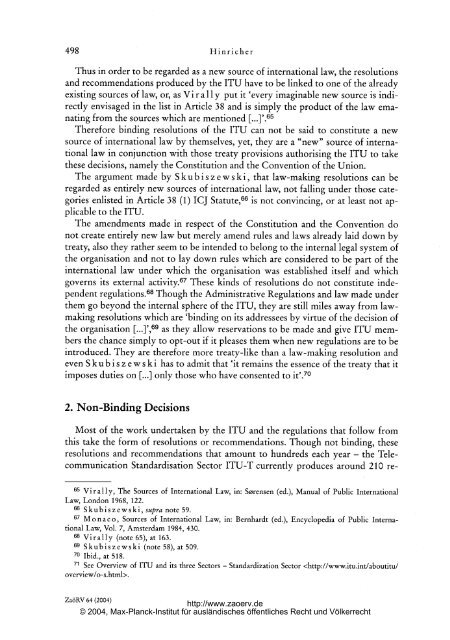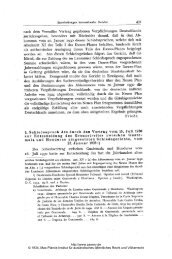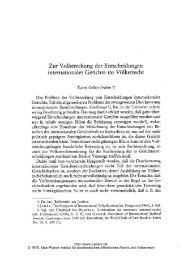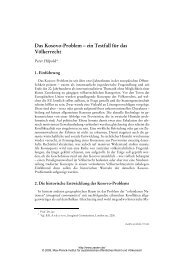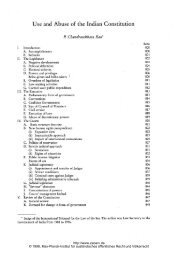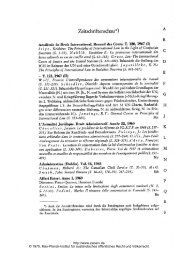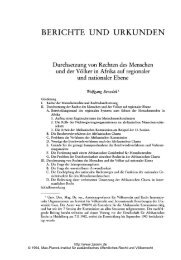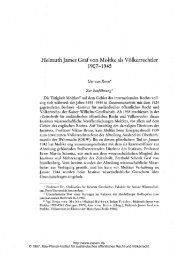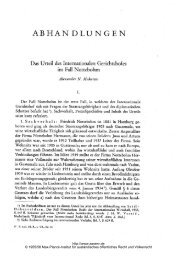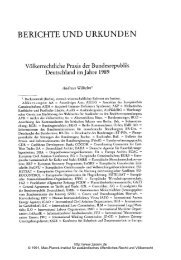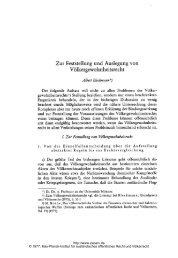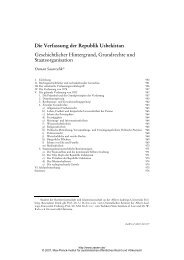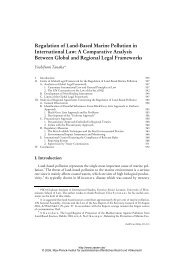The Law-Making of the International Telecommunication Union (ITU ...
The Law-Making of the International Telecommunication Union (ITU ...
The Law-Making of the International Telecommunication Union (ITU ...
Create successful ePaper yourself
Turn your PDF publications into a flip-book with our unique Google optimized e-Paper software.
498 Hinricher<br />
Thus in order to be regarded as a new source <strong>of</strong> international law, <strong>the</strong> resolutions<br />
and recommendations produced by <strong>the</strong> <strong>ITU</strong> have to be linked to one <strong>of</strong> <strong>the</strong> already<br />
existing sources <strong>of</strong> law, or, as V 1 r a 11 y put 1t 'every imaginable new source is indirectly<br />
envisaged in <strong>the</strong> list in Article 38 and is simply <strong>the</strong> product <strong>of</strong> <strong>the</strong> law ema-<br />
nating from <strong>the</strong> sources which are mentioned [ ]1.65<br />
<strong>The</strong>refore binding resolutions <strong>of</strong> <strong>the</strong> <strong>ITU</strong> can not be sald to constitute a new<br />
source <strong>of</strong> international law by <strong>the</strong>mselves, yet, <strong>the</strong>y are a "new-'-' source <strong>of</strong> interna-<br />
tional law in conjunction with those treaty provisions authorising <strong>the</strong> <strong>ITU</strong> to take<br />
<strong>the</strong>se decisions, namely <strong>the</strong> Constitution and <strong>the</strong> Convention <strong>of</strong> <strong>the</strong> <strong>Union</strong>.<br />
<strong>The</strong> argument made by S k u b 1 s z e w s k 1, that law-making resolutions can be<br />
regarded as entirely new sources <strong>of</strong> international law, not falling under those cate-<br />
66<br />
gories enlisted in Article 38 (1) ICJ Statute, is not convincing, or at least not ap-<br />
to <strong>the</strong> <strong>ITU</strong>.<br />
plicable<br />
<strong>The</strong> amendments made in respect <strong>of</strong> <strong>the</strong> Constitution and <strong>the</strong> Convention do<br />
not create entirely new law but merely amend rules and laws already laid down by<br />
treaty, also <strong>the</strong>y ra<strong>the</strong>r seem to be intended to belong to <strong>the</strong> internal legal system <strong>of</strong><br />
<strong>the</strong> organisation and not to lay down rules which are considered to be part <strong>of</strong> <strong>the</strong><br />
international law under which <strong>the</strong> organisation was established itself and which<br />
governs its external activity.67 <strong>The</strong>se kinds <strong>of</strong> resolutions do not constitute inde-<br />
68<br />
pendent regulations. Though <strong>the</strong> Administrative Regulations and law made under<br />
<strong>the</strong>m go beyond <strong>the</strong> internal sphere <strong>of</strong> <strong>the</strong> <strong>ITU</strong>, <strong>the</strong>y are still miles away from law-<br />
making resolutions which are 'binding on its addressees by virtue <strong>of</strong> <strong>the</strong> decision <strong>of</strong><br />
<strong>the</strong> organisation [ ]"69 as <strong>the</strong>y allow reservations to be made and glve <strong>ITU</strong> mein-<br />
bers <strong>the</strong> chance simply to opt-out 1f it pleases <strong>the</strong>m when new regulations are to be<br />
introduced. <strong>The</strong>y are <strong>the</strong>refore more treaty-like than a law-making resolution and<br />
even S k u b 1 s z e w s k 1 has to admit that 'it remains <strong>the</strong> essence <strong>of</strong> <strong>the</strong> treaty that 1t<br />
imposes duties on [ ] only those who have consented to itl.70<br />
2. Non-Binding Decisions<br />
Most <strong>of</strong> <strong>the</strong> work undertaken by <strong>the</strong> <strong>ITU</strong> and <strong>the</strong> regulations that follow from<br />
this take <strong>the</strong> form <strong>of</strong> resolutions or recommendations. Though not binding, <strong>the</strong>se<br />
resolutions and recommendations that amount to hundreds each year<br />
- <strong>the</strong><br />
Tele-<br />
communication Standardisation Sector <strong>ITU</strong>-T currently produces around 210 re-<br />
65 Virally, <strong>The</strong> Sources <strong>of</strong> <strong>International</strong> <strong>Law</strong>, in: Sorensen (ed.), Manual <strong>of</strong> Public <strong>International</strong><br />
<strong>Law</strong>, London 1968, 122.<br />
66 Skubiszewski, supra note 59.<br />
67<br />
Monaco, Sources <strong>of</strong> <strong>International</strong> <strong>Law</strong>, in: Bernhardt (ed.), Encyclopedia<br />
tional <strong>Law</strong>, Vol. 7, Amsterdam 1984, 430.<br />
68 V i r a 11 y (note 65), at 163.<br />
69 Skubiszewski (note 58), at 509.<br />
70 Ibid., at 518.<br />
71 See Overview <strong>of</strong> <strong>ITU</strong> and its three Sectors -<br />
overview/o-s.html>.<br />
ZaöRV 64 (2004)<br />
<strong>of</strong> Public Interna-<br />
Standardization Sector <http://wwwitu.int/aboutitu/<br />
http://www.zaoerv.de<br />
© 2004, Max-Planck-Institut für ausländisches öffentliches Recht und Völkerrecht


